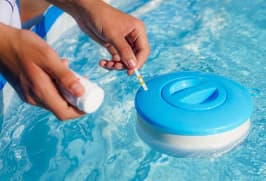Maintaining the right calcium hardness in your pool is one of the most important elements of water balance, protecting your pool’s surface, preventing equipment damage, and ensuring every swim is comfortable and safe. This 2025 guide walks you step-by-step through testing and raising calcium hardness for any pool type, with practical calculators, product tips, and expert troubleshooting.
Why Calcium Hardness Matters
Calcium hardness refers to the amount of dissolved calcium in your pool water. If levels are too low, your pool water becomes aggressive—literally pulling calcium from plaster, grout, tile, and metal, which leads to surface pitting, staining, and equipment corrosion. If levels are too high, scaling and cloudy water appear.
Key point: Maintaining the right calcium hardness protects your pool investment and extends the life of your surfaces and equipment.
Ideal Calcium Hardness Levels (By Pool Type)
| Pool Type | Optimal Range (ppm) |
|---|---|
| Plaster/Concrete | 250–400 |
| Vinyl | 175–250 |
| Fiberglass | 200–250 |
Tip: Always check your manufacturer’s recommendations for unique pool finishes.
Why Calcium Hardness Drops
- Dilution from rainwater or splash-out/refill routinely lowers hardness
- Filling with soft or low-calcium water
- High evaporation rates, especially in summer or arid climates
- Reverse osmosis filtration, which strips out minerals
Monitor calcium hardness at least once a month, or after major weather events or water additions.
How to Test Calcium Hardness in Your Pool
Step-by-step:
- Use a reliable pool test kit or digital meter—test strips are convenient but less precise.
- Sample water from at least elbow depth, away from returns and skimmers.
- Follow the specific kit instructions for best accuracy.
- For ultimate precision, bring a sample to a pool supply store.
Pro tip: Add a quarterly reminder to your calendar for in-depth water testing.
How to Raise Calcium Hardness In Pool
1. Calculate the Amount Needed
First, measure your current calcium hardness and determine your pool’s gallon/liter capacity.
- General rule: 1.25 lbs (approx. 570 grams) of pool-grade calcium chloride raises calcium hardness by 10 ppm in 10,000 gallons (about 38,000 liters).
- Use an online calcium hardness calculator for convenience.
2. Choose the Right Product
- Look for: Calcium chloride branded for pools (“calcium hardness increaser”). Popular and safe options include hydrated and anhydrous calcium chloride.
- Compare brands for dissolving speed and cost-effectiveness.
3. Safe Mixing & Application
- Pre-dissolve the calculated dose in a clean bucket of pool water (never add water to chemical!).
- Always add product to water, not the reverse, to prevent hazardous reactions.
- Wear gloves and eye protection—calcium chloride can irritate skin and eyes.
- Circulate pool water with your pump running.
- Pour the mixture slowly around the pool perimeter for even distribution.
4. Wait & Retest
- Allow at least 6–8 hours of circulation.
- Retest the calcium hardness level—repeat the process if it’s still below your target.
Water Balance & Saturation Index (LSI)
To prevent scaling or etching, keep the full water balance in check:
- pH: 7.2–7.6
- Total alkalinity: 80–120 ppm
- Calcium hardness: per table above
- Langelier Saturation Index (LSI): Aim for +0.1 to +0.3 (slightly positive)
- Consider using a pool LSI calculator for best results.
Special Considerations
Calcium Hardness for Saltwater Pools
Salt chlorinators can accelerate scaling at high hardness—stay in the middle of recommended ranges and clean cells regularly.
Vinyl, Fiberglass & Plaster Pool Nuances
Lower calcium levels are safer for vinyl/fiberglass pools, while plaster/concrete pools require more to protect finishes.
Emergency Corrections
If calcium levels are dangerously low, close the pool until corrected to prevent irreversible surface damage.
Interactive Features
- Dosage Calculator: Instantly figure out how much product you need (add embed or link).
- Testing & Maintenance Schedule Template: Download and print for regular use.
- Infographic: Visual step-by-step on raising calcium hardness.
Frequently Asked Questions
Can I use calcium chloride from the hardware store?
If it’s 100% calcium chloride and contains no anti-caking agents or additives, yes—but pool-specific products are best.
How long after adding calcium can I swim?
Wait until the pool pump has circulated the water for at least one complete cycle (usually 6–8 hours), then retest to confirm levels.
How often should I test calcium hardness?
At least monthly, and after any major water addition or rainfall.
Does baking soda increase calcium hardness?
No. It raises alkalinity, not calcium hardness.
What’s the difference between calcium hardness and total hardness?
Calcium hardness specifically measures calcium ions; total hardness includes all dissolved minerals.
Final Tips & Summary
- Keep calcium, pH, and alkalinity balanced—neglecting one impacts the others!
- Regular maintenance prevents surface and equipment failure—saving major costs.
- For complex problems or stubborn water imbalance, consult a pool professional.
Keeping your calcium hardness on target year-round ensures your pool is clear, safe, and protected—swim happy!
Need help selecting a product or troubleshooting persistent calcium issues? Contact Deep Blue Pool & Spa for expert advice.





Comments are closed